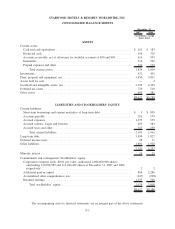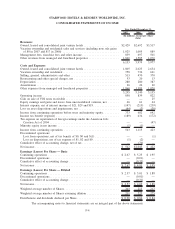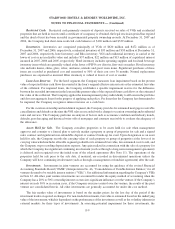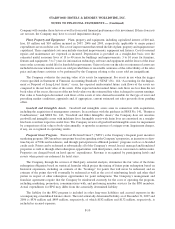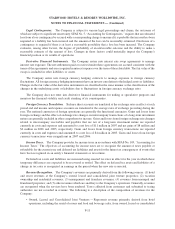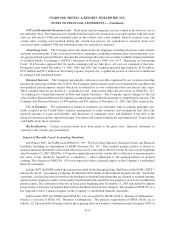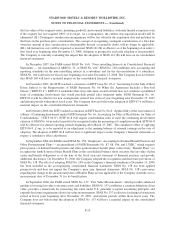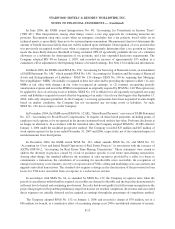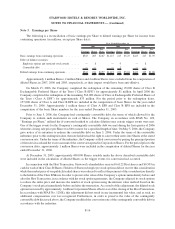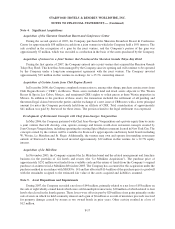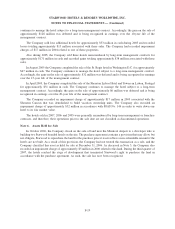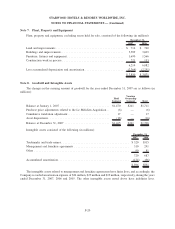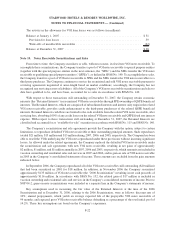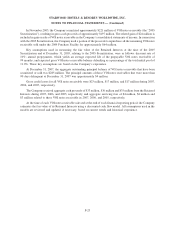Starwood 2007 Annual Report Download - page 133
Download and view the complete annual report
Please find page 133 of the 2007 Starwood annual report below. You can navigate through the pages in the report by either clicking on the pages listed below, or by using the keyword search tool below to find specific information within the annual report.VOI and Residential Inventory Costs. Real estate and development costs are valued at the lower of cost or
net realizable value. Development costs include both hard and soft construction costs and together with real estate
costs are allocated to VOIs and residential units on the relative sales value method. Interest, property taxes and
certain other carrying costs incurred during the construction process are capitalized as incurred. Such costs
associated with completed VOI and residential units are expensed as incurred.
Advertising Costs. The Company enters into multi-media ad campaigns, including television, radio, internet
and print advertisements. Costs associated with these campaigns, including communication and production costs,
are aggregated and expensed the first time that the advertising takes place in accordance with the American Institute
of Certified Public Accountants (“AICPA”) Statement of Position (“SOP”) No. 93-7, “Reporting on Advertising
Costs.” If it becomes apparent that the media campaign will not take place, all costs are expensed at that time.
During the years ended December 31, 2007, 2006 and 2005, the Company incurred approximately $116 million,
$135 million and $117 million of advertising expense, respectively, a significant portion of which was reimbursed
by managed and franchised hotels.
Retained Interests. The Company periodically sells notes receivable originated by our vacation ownership
business in connection with the sale of VOIs. The Company retains interests in the assets transferred to qualified and
non-qualified special purpose entities which are accounted for as over-collateralizations and interest only strips.
These retained interests are treated as “available-for-sale” transactions under the provisions of SFAS No. 115,
“Accounting for Certain Investments in Debt and Equity Securities.” The Company reports changes in the fair
values of these Retained Interests through the accompanying consolidated statement of comprehensive income. The
Company had Retained Interests of $40 million and $51 million at December 31, 2007 and 2006, respectively.
Use of Estimates. The preparation of financial statements in conformity with accounting principles gen-
erally accepted in the United States requires management to make estimates and assumptions that affect the
reported amounts of assets and liabilities and disclosure of contingent assets and liabilities at the date of the
financial statements and the reported amounts of revenues and expenses during the reporting period. Actual results
could differ from those estimates.
Reclassifications. Certain reclassifications have been made to the prior years’ financial statements to
conform to the current year presentation.
Impact of Recently Issued Accounting Standards.
In February 2007, the FASB issued SFAS No. 159, “The Fair Value Option for Financial Assets and Financial
Liabilities Including an Amendment of FASB Statement No. 115.” This standard permits entities to choose to
measure financial instruments and certain other items at fair value and is effective for the first fiscal year beginning
after November 15, 2007. SFAS No. 159 must be applied prospectively, and the effect of the first re-measurement to
fair value, if any, should be reported as a cumulative — effect adjustment to the opening balance of retained
earnings. The adoption of SFAS No. 159 is not expected to have a material impact on the Company’s consolidated
financial statements.
In June 2007, the FASB ratified the consensus reached by the Emerging Issues Task Force of the FASB (“EITF”)
in Issue No. 06-11, “Accounting for Income Tax Benefits of Dividends on Share-Based Payment Awards.” Under this
consensus, a realized income tax benefit from dividends or dividend equivalents that are charged to retained earnings
and are paid to employees under certain equity-based benefit plans should be recognized as an increase in additional
paid-in capital. The consensus is effective in fiscal years beginning after December 15, 2007 and should be applied
prospectively for income tax benefits derived from dividends declared after adoption. The adoption of EITF 06-11 is
not expected to have a material impact on the Company’s consolidated financial statements.
In December 2007, the FASB issued SFAS No. 141 (revised 2007) (SFAS 141(R)), “Business Combinations,”
which is a revision of SFAS 141, “Business Combinations.” The primary requirements of SFAS 141(R) are as
follows: (I.) Upon initially obtaining control, the acquiring entity in a business combination must recognize 100% of
F-13
STARWOOD HOTELS & RESORTS WORLDWIDE, INC.
NOTES TO FINANCIAL STATEMENTS — (Continued)


